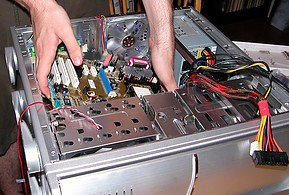--This post may contain affiliate links. I receive a small amount of commission on any purchases through links on my site. Which will totally be blown on upgrading my gaming PC!!--
What is a motherboard in a computer? The motherboard is technically the main component of a computer as this is what connects all the other components together. It is a printed circuit board that allocates power and connectivity to all the different components such as RAM, CPU, graphics card and your storage devices. You can get numerous sizes of motherboards to fit the different size computer available. Each different type of motherboard is designed to work with different processors and different types of memory, whereas graphics cards and storage devices are mostly universal. For example, you will need to take note of the CPU socket on the motherboard to make sure your CPU is compatible. A Ryzen CPU is classed as an AM4 socket when the older AMD FX range is an AM3+ socket but when you look at Intel there is a bigger variety again. When you look at Memory you will need to figure out what DDR your motherboard will take as you have the option of the latest option of DDR4 then you have DDR3, which is still common, and DDR2 which is more unlikely.
Motherboard Components
All motherboards have a massive list of components which vary for the different brands and model of it, however I want to  talk about the main components that you are going to need to know to build/ understand you PC. First off you have the CPU socket, there will be an arrow in the corner of the socket that you would need to match with the arrow on your CPU to be able to get it to slot in correctly. You also have memory or ram slots, anywhere for 2 to 8 slots depending on the motherboard that you go for. You might have an M.2 SSD storage slot depending on how modern your motherboard it. When it comes to connecting your motherboard up you have a 24 pin power connector which is the main power source for your power supply unit (PSU), along with SATA connectors where you would connect your hard drives or SSD for your motherboard to read. There are also 3 pin fan connectors and LED connectors so you are able to power up your fans if you have standard or LED ones. There will be a bank of connectors where you would connect the power button, headphone and mic socket from the front panel of your case, and also the USB header for the front panel. You will have either 1 or 2 video card ports, again this depends on the size. When it comes to plugging your computer in you will have the HDMI port and the ethernet port for your internet connectivity with a couple more USB ports.
talk about the main components that you are going to need to know to build/ understand you PC. First off you have the CPU socket, there will be an arrow in the corner of the socket that you would need to match with the arrow on your CPU to be able to get it to slot in correctly. You also have memory or ram slots, anywhere for 2 to 8 slots depending on the motherboard that you go for. You might have an M.2 SSD storage slot depending on how modern your motherboard it. When it comes to connecting your motherboard up you have a 24 pin power connector which is the main power source for your power supply unit (PSU), along with SATA connectors where you would connect your hard drives or SSD for your motherboard to read. There are also 3 pin fan connectors and LED connectors so you are able to power up your fans if you have standard or LED ones. There will be a bank of connectors where you would connect the power button, headphone and mic socket from the front panel of your case, and also the USB header for the front panel. You will have either 1 or 2 video card ports, again this depends on the size. When it comes to plugging your computer in you will have the HDMI port and the ethernet port for your internet connectivity with a couple more USB ports.
Motherboard Form Factors

There are a few different sized motherboards that you can go for, which are classed as form factors. The most common sizes that you will come across is ATX, Micro ATX and Mini ATX. The ATX motherboard is the normal board that you can go for it will fit in any full size case that you have because all brands have the same fittings. If you want to go down a size you have Micro ATX and Mini ATX, these will also fit in some normal size PC cases as again they have all the same fitting across the different brands, however for these sizes you are able to get smaller cases if you are tight on space, you just aren’t able to have as many fans, storage or memory and you may need to consider getting a low profile graphics card as it won’t fit in these smaller cases. You can do down to Nano ITX that are smaller lower power consuming motherboards that are more aimed at digital entertainment systems or media centers. If we go the other way to the Extended ATX which is just a bit bigger than the ATX case, because of this you would usually get more RAM slots and more slots for graphics cards. However, you wouldn’t fit this in a normal size case unless it states otherwise.
Brands of Motherboard
You have a massive choice of manufactures of motherboards to choose from when you go to buy one, but there is only a handful that is classed as the top ones which are Asrock, Asus, EVGA, Gigabyte, and MSI. All of these are massive in the computer industry with many of them offering more than just motherboards as they have graphics cards and power supply units. Each one of these manufactures will release may different models of each motherboard with a cheaper more basic option up to the top of the range for the more specific needs. You will need to look at your budget and components that you have or are interested in purchasing before you consider your motherboard, or you can look at it that you should decide what motherboard you want before you go ahead with any other components.



How to Fit a Motherboard
When it comes to fitting the motherboard there is only one way to do it, however there are different orders. For instance,  you can fit the motherboard into the case, all you have to do is line the screw holes up and screw it in, you may need to screw in some stand-off screws into the case first if they aren’t already there, once you have it screwed in you can install the CPU, the cooler, ram and wiring. Another way of doing it which can be easier is to install the CPU and cooler onto the motherboard beforehand then fitting the motherboard to the case. This is up to you, you may find different ways easier than others but as we said there is only one way the motherboard mounts. One thing to remember before fitting the motherboard is to make sure that you fit the IO shield in the back of the case as this protects the ports from being jarred around along with keeping it as clean as possible.
you can fit the motherboard into the case, all you have to do is line the screw holes up and screw it in, you may need to screw in some stand-off screws into the case first if they aren’t already there, once you have it screwed in you can install the CPU, the cooler, ram and wiring. Another way of doing it which can be easier is to install the CPU and cooler onto the motherboard beforehand then fitting the motherboard to the case. This is up to you, you may find different ways easier than others but as we said there is only one way the motherboard mounts. One thing to remember before fitting the motherboard is to make sure that you fit the IO shield in the back of the case as this protects the ports from being jarred around along with keeping it as clean as possible.



10 Responses
Great article ! I hobestly always talk about motherboards but never really knew what they were. Now I have a better understanding of what motherboards are and how they work. Maybe now I can put together a computer, or not. Thanks for the info !
Thank you very much! it is a lot easier than it looks!
Thank you
This is a great article about fitting motherboard.I was very interesting at technologe and people may learn more from it,but it is difficult for new beginners just by reading these texts.So I suggest that author may add
a video or something like this about how one can fit a motherboard step by step.
Thank you for the feedback, it is something I am considering! thank you for letting me know
Thank you
Hey this is an excellent overview of motherboards. I must admit it has been (very) many years since I put together a PC. It was one of those things I used to do every other year or so when I lived in the Netherlands. They used to have this massive annual computer fair and all computer geeks from across the country and from Belgium and Germany would converge on this site to buy cases, PSUs, motherboards, ram, graphics cards etc. And as the day got closer and closer to the end of the fair, the vendors with inventory still to sell would be slashing prices and it would become this massive free for all. Around 5.30 when we were all kicked out there would be streams of hundreds of people dragging boxes strapped to folding wheelie luggage carts back to car parks or the train station. Then for about a week the whole country went quiet as everyone was stuck at home trying to put the pieces together and make them work. This was the late 1990s and there were always issues with compatibility that you had to look out for, Even though some pieces would physically fit together that didn’t necessarily mean they would work together. I guess compatibility is still an issue these days? Is this an issue you will be getting into at some point – as I’m sure anyone putting PC’s together needs to get this part right. Thanks and best regards, Andy
Thank you very much for your time! They still do quite a few fares around the UK as well very similar to what you have spoke about! Most of the time now if isn’t compatible they don’t usually fit, but there are still cases of this!
Thank you again
Wow very lucid post on mother board. I had a quick question: Does getting a blue screen on your computer means a motherboard issue or a bad driver ? I have often come across this issue. Throw some light on this…please.
Thank you for your time! unfortunately there are a couple of things that could be, the cheapest option would be to check drivers and software first then potentially start checking hardware
Great article good use of words and the way it is written in general it kept me interested throughout and wanting to read more!
Very good, 🙂
Thank you very much for the feedback!